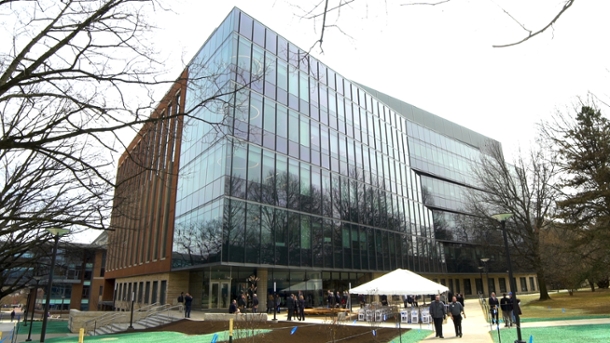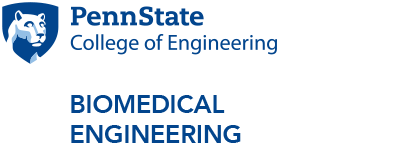
Penn State President Eric Barron (right) addresses ribbon cutting attendees while Justin Schwartz, the Harold and Inge Marcus Dean of the Penn State College of Engineering, looks on.
Ribbon cutting dedicates new Chemical and Biomedical Engineering Building
Ceremony highlights state-of-the-art building's future impact on teaching, research
4/4/2019
UNIVERSITY PARK, Pa. — A ribbon-cutting ceremony on April 4 marked the official opening of the new Chemical and Biomedical Engineering (CBE) Building on the Penn State University Park campus. The 109,100-square-foot, six-level facility near the intersection of Shortlidge and Curtin Roads houses the Departments of Chemical Engineering and Biomedical Engineering.
The recently completed $144 million building was designed by architectural firm HOK, and construction was managed by general contracting company Barton Malow. The structure features a variety of laboratories, classrooms and conference rooms, student common areas, the Dow Chemical Knowledge Commons collaborative student space, and an auditorium for presentations and classes that holds approximately 150 people.
In his remarks at the ceremony, Justin Schwartz, the Harold and Inge Marcus Dean of the Penn State College of Engineering, envisioned high-impact research and teaching happening in the building, with great potential benefits for society.
“It will allow the Department of Chemical Engineering and the Department of Biomedical Engineering to continue to thrive as they inspire change and impact tomorrow,” said Schwartz. “It’s here that students will grow into world-class, socially aware, globally connected engineers, educators and researchers who work inclusively to develop solutions to the world’s most pressing problems. With this space and state-of-the-art instruments, students and researchers alike wield the tools necessary to engineer results where we need them most.”
Joining Schwartz as speakers at the ceremony included Penn State President Eric Barron; Robert Fenza, University Board of Trustees member and retired executive vice president and chief operating officer of Liberty Property Trust; Phillip Savage, head of the Department of Chemical Engineering; and Cheng Dong, head of the Department of Biomedical Engineering.

Cutting the ribbon for the new Chemical and Biomedical Engineering Building are (from left to right) Cheng Dong, head of the Department of Biomedical Engineering; Phillip Savage, head of the Department of Chemical Engineering; Penn State President Eric Barron; Robert Fenza, University Board of Trustees member; and Justin Schwartz, the Harold and Inge Marcus Dean of the Penn State College of Engineering.
“This building is a new beginning for the department, and it ushers in a new era for us,” said Phillip Savage, head of the Department of Chemical Engineering. “It is the first time the department has had in one place all of the different types of spaces one needs for modern engineering education, research and building of community.”
Since 2012-13, the Department of Biomedical Engineering has grown from 9 to 20 faculty, with plans to hire four more in the next several years. The number of students has also expanded rapidly.
“In our first graduation class in spring 2005, we had 17 undergraduates receive their diplomas and this academic year, we expect that to grow seven-fold to 119,” said Cheng Dong, head of the Department of Biomedical Engineering. “Also, our number of Ph.D. students has more than doubled since 2012-13 and the number of Ph.D.’s awarded has increased four-fold. We needed room to keep growing and we have that now. It’s very exciting.”
Research at the CBE Building will be conducted in labs with several unique features. Many of the teaching and research laboratories are situated along corridors with transparent glass walls that enable visitors and prospective students to observe the work happening within. The walls outside the labs serve as magnetic whiteboards for writing formulas and facilitating impromptu discussions. Also, instead of being completely separated in different rooms, many of the labs will be in an open format in a large room, known as a “lab neighborhood.”
“The ‘neighborhood’ concept locates together different labs conducting similar types of research, which will facilitate collaborations and build more bridges between research groups,” said Savage.

The Chemical and Biomedical Engineering Building
The building was constructed with environmental concerns in mind. It was aligned as not to disturb the root systems of the nearby dawn redwood trees, and more than one ton of recycled glass was used for the terrazzo floor in the main lobby.
Another feature has less to do with the CBE Building itself, and more to do with its location. Situated in the middle of University Park’s life sciences, chemical sciences and materials sciences hub, the CBE Building is well-positioned for interdisciplinary collaboration.
“The building’s location is quite valuable for a department like ours, one that recognizes the value of interdisciplinary research and education,” said Dong. “We have already built so many relationships with our colleagues in multiple disciplines, and these collaborations have led to several biomedical health science breakthroughs and technology advancements. But now, we can better achieve future success.”
The new amenities are expected to help attract top faculty members and students to both departments. Staff and some faculty members and graduate students have moved into their new office spaces, with the rest of the faculty and graduate students moving in during late spring and early summer. Laboratories are scheduled to be fully functional by late summer, with the first classes in the new building taking place this fall.



